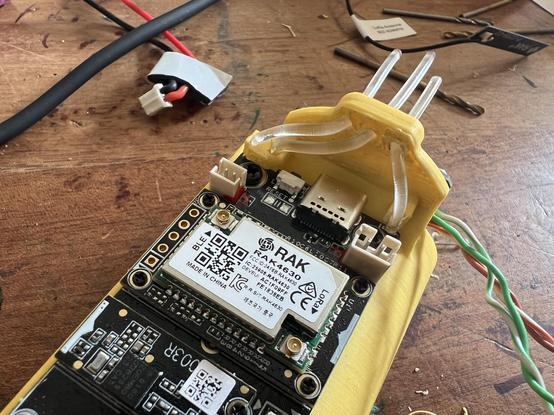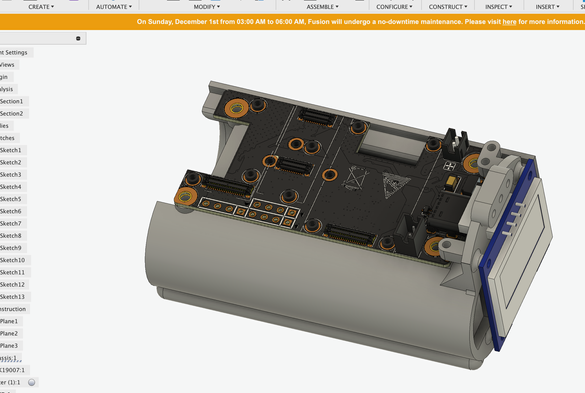Well shit! Designed this whole light pipe situation for this #meshtastic enclosure, thought it would be sick! But transparent PLA makes a TERRIBLE fibre optic cable. Any suggestions? Big ass fishing line? #3dprinting #lightpipe #fibreoptic #fiberoptic
#lightpipe
The Light Guide Hiding In Your Extrusion
There should be a line of jokes that start "A physicist and an engineer walk into a bar…". In my case I'm an engineer and my housemate is a physicist, so random conversations sometimes take interesting turns. Take the other day for example, as one does when talking she picked up a piece of aluminium extrusion that was sitting on our coffee table and turned it over in her hands. It has a hole down its centre and it's natural to peer down it, at which point her attention was caught by the appearance of a series of concentric rings of light. Our conversation turned to the mechanism which might be causing this, and along the way took us into cameras, waveguides, and optical fibres.
The light reaching us after traveling along a straight narrow tube should at a cursory glance be traveling in a straight line, and indeed when I point the extrusion out of my window and look down it I can see a small segment of the tree in the distance I've pointed it at. It didn't take us long to conclude that the concentric rings were successive reflections of the light coming into the end hole from off-centre angles.
In effect, the extrusion is a pinhole camera in which the image is projected onto the inside of a cylinder stretching away from the pinhole rather than onto a flat piece of film, and we were seeing the successive reflections of the resulting distorted image as they bounced to and fro down the tube towards us. It's likely the imperfect mirror formed by the aluminium wall allowed us to see each image, as light was being diffused in our direction. Adding a piece of tape with a small pinhole at the end accentuated this effect, with the circles becoming much more sharply defined as the projected image became less blurry.
The Annals of the Bleeding Obvious
Total internal reflection of a HeNe laser beam in a piece of acetate. Sai2020 (Public domain).
So great, we've invented the pinhole camera, where's our Nobel Prize? Our place in the esteemed scientific journal Annals of the Bleeding Obvious is evidently assured. But on the other hand, we've explored the mechanism used by light pipes and fibre optic communication, namely the passage of light along a waveguide through successive reflections from its internal walls.
It's not much use with a piece of extrusion because it's bulky and not flexible, but when the medium is switched to a piece of laser-cut acrylic the same technique can be used to great effect. Edge-lit acrylic displays are hardly a new idea, but in the age of the LED and perhaps more pertinently the expensive Nixie tube, they appear to have made something of a comeback.
Of more interest is the idea that each of those concentric rings is a successive reflection of the image projected by the pinhole. In our idle discussion around the coffee table we surmised that with some image processing or suitable lenses it could be mapped from a cylindrical reflection to a flat one in the manner of a photograph we're all used to. Could such an image travel round curves in the light pipe and be used for remote sensing? That scientific journal just called again, we've just invented the endoscope.
What have you reinvented lately?
Big LED Matrix Becomes Tiny LED Matrix Thanks to Fiber Optics
Everyone loves LED matrices, and even if you can't find what you like commercially, it's pretty easy to make just what you want. Need it big? No problem; just order a big PCB and some WS2812s. Need something tiny? There are ridiculously small LEDs that will test your SMD skills, as well as your vision.
But what if you want a small matrix that's actually a big matrix in disguise? For that, you'll want to follow [elliotmade]'s lead and incorporate fiber optics into your LED matrix. The build starts with a 16×16 matrix of WS2812B addressable LEDs, with fairly tight spacing but still 160 mm on a side. The flexible matrix was sandwiched between a metal backing plate and a plastic bezel with holes directly over each LED. Each hole accepts one end of a generous length of flexible 1.5-mm acrylic light pipe material; the other end plugs into a block of aluminum with a 35 by 7 matrix of similar holes. The small block is supported above the baseplate by standoffs, but it looks like the graceful bundle of fibers is holding up the smaller display.
A Raspberry Pi Pico running a CircutPython program does the job of controlling the LEDs, and as you can see in the video below, the effect is quite lovely. Just enough light leaks out from the fibers to make a fascinating show in the background while the small display does its thing. We've seen a few practical uses for such a thing, but we're OK with this just being pretty. It does give one ideas about adding fiber optics to circuit sculptures, though.
#ledhacks #acrylic #fiberoptics #led #lightpipe #matrix #neopixel #pico #pmma #raspberrypi #rgb #ws2812b
Parts Shortage Forces Creativity for this Recursive Clock of Clocks
We've been seeing a lot of metaclocks lately -- a digital clock whose display is formed by the sweeping hands of an array of individual analog clocks. They can look fantastic, and we've certainly seen some great examples.
But in this time of supply pinches, it's not always possible to gather the parts one needs for a full-scale build. Happily, that didn't stop [Erich Styger] from executing this circular multi-metaclock with only thirteen of his custom dual-shaft stepper analog movements. Normally, his clocks use double that number of movements, which he arranges in a matrix so that the hands can be positioned to form virtual seven-segment displays. By arranging the movements in a circle, the light-pipe hands can mimic an analog clock face, or perform any of [Erich]'s signature "intermezzo" animations, each of which is graceful and engaging to watch. Check out a little of what this charmingly recursive clock has to offer in the video below.
[Erich] could easily have gotten stuck on the original design -- he's been at this metaclock game for a while, after all. The fact that the reduced part count forced him to get creative on the display is the best part of this build, at least to us.
#clockhacks #analog #clock #digital #lightpipe #meta #metaclock #neopixel
Digital X-Ray Scanner Teardown Yields Bounty of Engineering Goodies
We'll just go ahead and say it right up front: we love teardowns. Ripping into old gear and seeing how engineers solved problems -- or didn't -- is endlessly fascinating, even for everyday devices like printers and radios. But where teardowns really get interesting is when the target is something so odd and so specialized that you wouldn't normally expect to get a peek at the outside, let alone tramp through its guts.
[Mads Barnkob] happened upon one such item, a Fujifilm FCR XG-1 digital radiography scanner. The once expensive and still very heavy piece of medical equipment was sort of a "digital film system" that a practitioner could use to replace the old-fashioned silver-based films used in radiography, without going all-in on a completely new digital X-ray suite. It's a complex piece of equipment, the engineering of which yields a lot of extremely interesting details.
The video below is the third part of [Mads]' series, where he zeroes in on the object of his desire: the machine's photomultiplier tube. The stuff that surrounds the tube, though, is the real star, at least to us; that bent acrylic light pipe alone is worth the price of admission. Previous videos focused on the laser scanner unit inside the machine, as well as the mechatronics needed to transport the imaging plates and scan them. The video below also shows experiments with the PM tube, which when coupled with a block of scintillating plastic worked as a great radiation detector.
We've covered a bit about the making of X-rays before, and a few of the sensors used to detect them too. We've also featured a few interesting X-ray looks inside of tech, from a Starlink dish to knock-off adapters.
Thanks for the heads up on this one, [Adrian]!
#medicalhacks #teardown #acrylic #laser #lightpipe #medical #photomultiplier #pm #radiography #scanner #scintillation #xray


